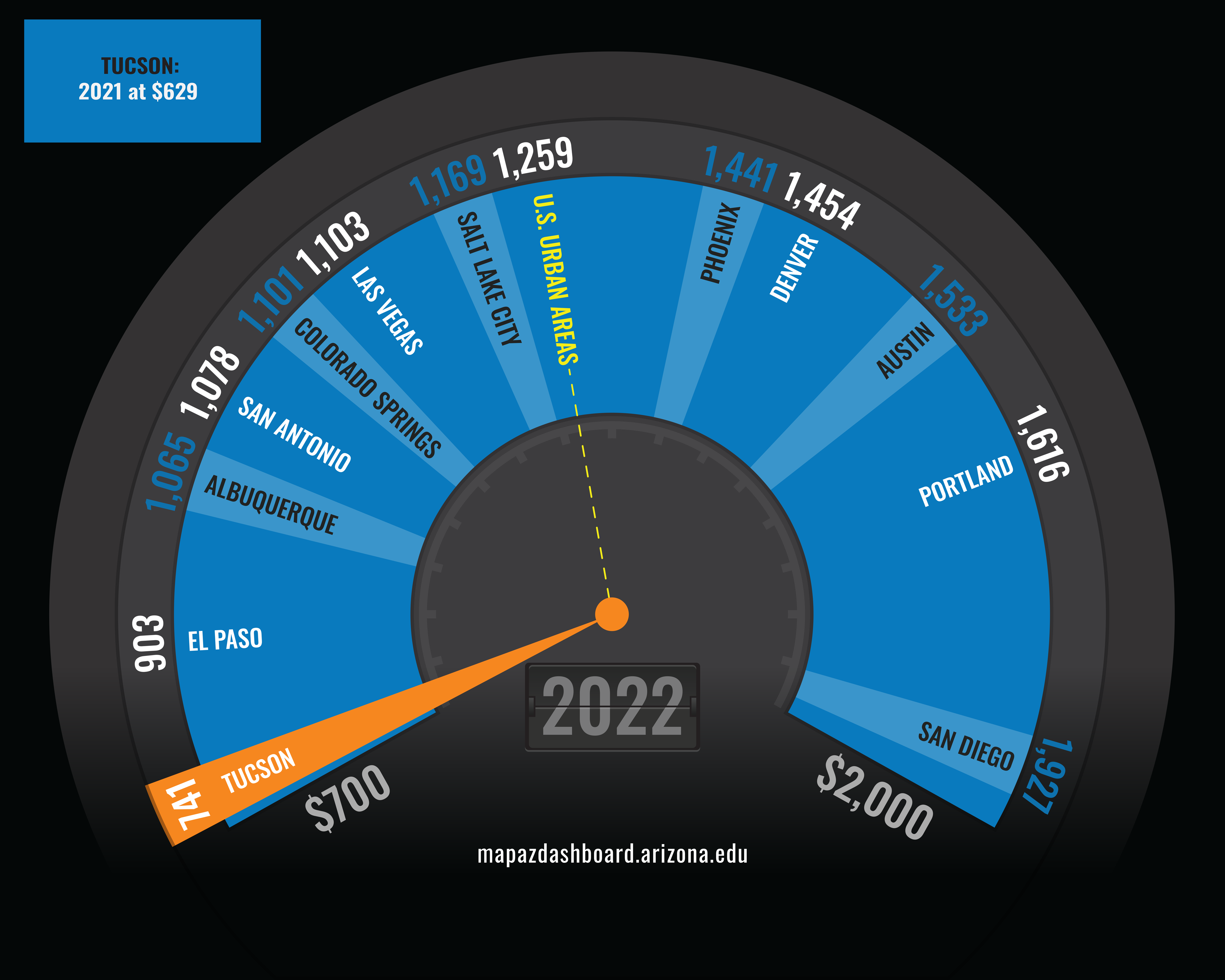 Analyze Statistics on Commuting Trends in Tucson, Arizona MSA
Analyze Statistics on Commuting Trends in Tucson, Arizona MSA
How are we doing?
Annual Congestion Costs per Auto Commuter (2022)

The Tucson urban area had the lowest congestion cost per commuter compared to peer urban areas in 2022 at $741. The San Diego urban area had the highest congestion cost per commuter at $1,927, more than double Tucson. Congestion costs per commuter for the Tucson urban area increased between 2021 and 2022 by $112. That increase was driven by 6 additional hours of travel time per commuter and a slight increase in the value of time per hour. Tucson's congestion costs in 2022 are below pre-pandemic levels.
Congestion costs are comprised of two components: the value of the extra travel time (delay) and excess fuel consumed by vehicles traveling at slower speeds. Congestion costs vary significantly from other congestion indicators, like delay hours, due to price variations in fuel across states. For example, in 2022 the average state fuel cost in Arizona was $4.49, while in California it was $6.38. The value of time in 2022 was consistent across all urban areas at $23.12.
The MAP Dashboard typically reports data for the Metropolitan Statistical Area. However, traffic congestion data is only available at the urban area level. Urban areas are located within a metropolitan region and have a population density of more than 1,000 persons per square mile. They are typically smaller than the metropolitan region which is comprised of counties. The geographic outline for each urban area reported here can be found in the Urban Mobility Report.
Why is it important?
The length of time it takes a commuter to get to work has an impact on one's quality of life and a region's economic well-being. Long commute times and congestion have a direct impact on the costs associated with getting to work and the value of one's time. According to the Texas A&M Transportation Institute (TTI), the nationwide cost of traffic congestion in 2022 was $224 billion, which averaged $1,259 per auto commuter. In terms of time, commuters wasted 845 billion hours, or an average of 54 hours per commuter - that equals more than a typical work week spent traveling due to delays.
How do we compare?
Annual delay per auto commuter is the extra time (in hours) spent traveling at less than free-flow speeds by private vehicle drivers and passengers in typical peak periods. A commuter is considered one of these "peak-period travelers" and makes a trip between 6 - 10 a.m. or 3 - 7 p.m. Delays can be caused by bad weather, traffic accidents, or road construction.
In 2022, the Tucson urban area had the second-lowest number of delay hours per commuter at 39. Only commuters in El Paso experienced fewer delay hours at 38. The Portland urban area reported the highest number of delay hours per commuter at 70, just slightly ahead of Phoenix at 69. Overall, the U.S. urban areas reported 54 annual delay hours per commuter. Of the urban areas explored on the MAP, slightly more than half had fewer delay hours. The additional delay hours result in excess fuel costs. The 39 hours of delay in the Tucson urban area resulted in an additional 14 gallons of gasoline for each auto commuter. The trend for excess fuel consumption can be found on the Congestion Trends comparison page.
The number of auto commuters in the Tucson urban area increased significantly since 1990. Between 1990 and 2000 the number of auto commuters increased by 37.6% bringing the total to 293,000. The number of auto commuters continued to increase significantly between 2000 and 2010 adding more than 100,000 additional commuters on the roadways. That increase began to level off with the percentage of commuters increasing by only 9.1% between 2010 and 2020. This trend was fairly consistent across all of the urban areas explored. During the pandemic, the number of auto commuters in Tucson, and across the nation, fell drastically. As of 2022, the number of auto commuters in the Tucson urban area was below its pre-pandemic peak.
What are the key trends?
The overall trend in congestion, both delay and costs, increased at a steady rate between 1982 and 2020. During the first year of the pandemic, congestion declined sharply as many individuals worked from home, thus reducing commuting traffic significantly. Post-pandemic urban areas have seen a steep increase in traffic congestion. At the national level, congestion in urban areas has just about reached its pre-pandemic level, while Phoenix has surpassed its pre-pandemic level of delay hours by 8. That is the largest increase among peer urban areas between 2019 and 2022. Tucson remains below pre-pandemic levels by 11 hours.
How is it measured?
Traffic congestion data comes from the 2023 Urban Mobility Report. The report was published by the Texas A&M Transportation Institute and is sponsored by the Texas Department of Transportation. The 2023 report uses crowdsourced data from INRIX on urban streets and highways along with highway inventory data from a Federal Highway Administration database. This report provides congestion estimates for 494 U.S. urban areas. Some known criticisms of the Urban Mobility Report include the lack of peer review, the definition of “congestion” as less than free-flow speeds, and the focus on mobility rather than access. INRIX also produces an annual Global Traffic Scorecard.












